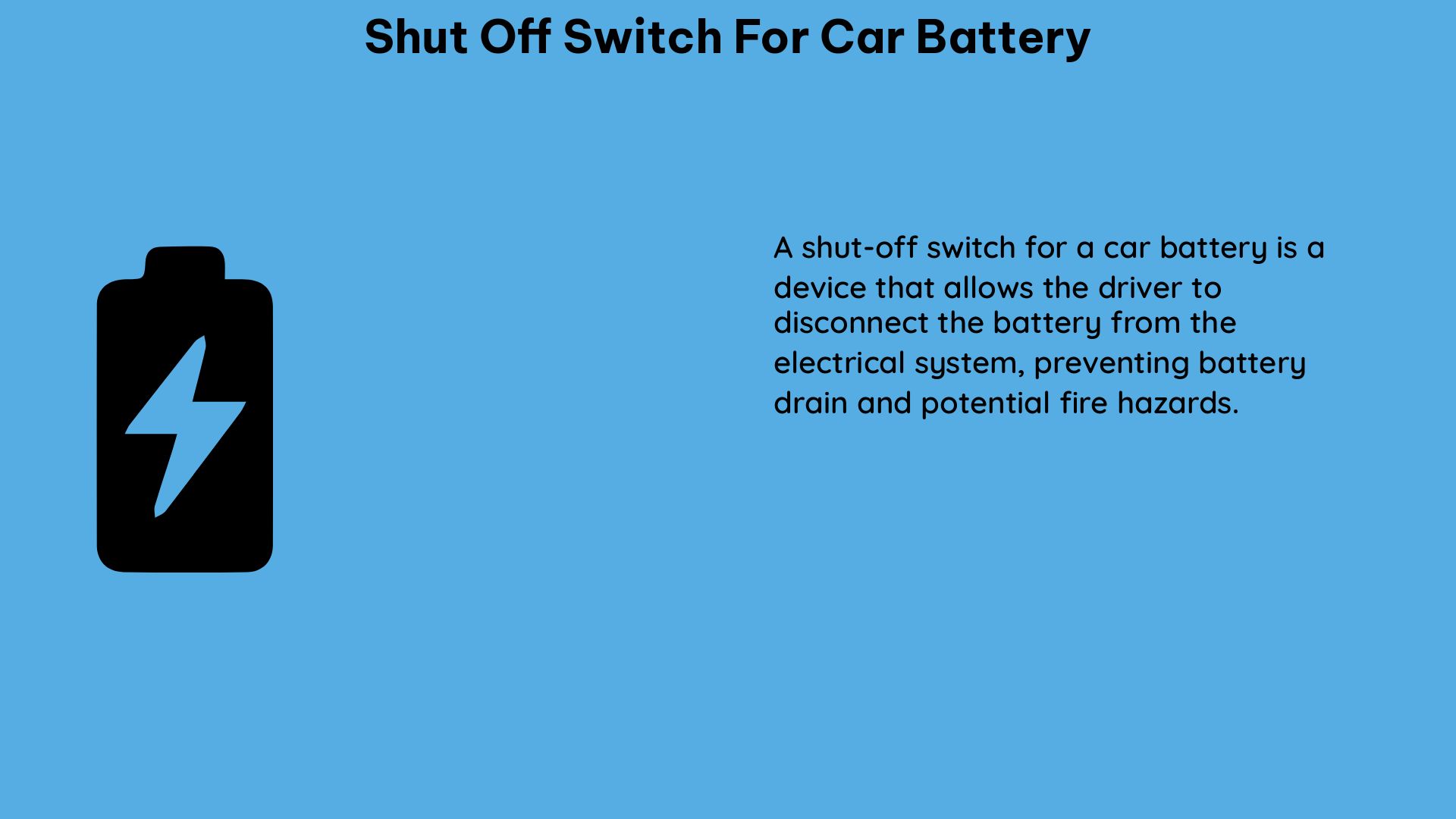The shut off switch for a car battery is an essential safety feature that can prevent battery drain, protect the electrical system during maintenance, and serve as a theft deterrent. This comprehensive guide will delve into the technical specifications, installation process, and best practices for selecting and using a shut off switch for your vehicle.
Technical Specifications of Shut Off Switch for Car Battery
When choosing a shut off switch for your car battery, it’s crucial to consider the following technical specifications:
Amperage Ratings
- Continuous Amperage Rating: This rating should be higher than the maximum continuous current draw of your vehicle’s electrical system. For example, if your car’s electrical system has a maximum continuous current draw of 80 amps, you’ll need a switch with a continuous amperage rating of at least 100 amps.
- Surge Amperage Rating: This rating should be higher than the starting current of your engine. A typical car battery with a Cold Cranking Amps (CCA) rating of 900 amps would require a switch with a surge amperage rating of at least 900 amps to ensure reliable starting.
Voltage Rating
- The shut off switch should be rated for 12V DC, which is the standard voltage for most automotive electrical systems.
Contact Material
- The switch’s contacts should be made of copper or silver alloy to ensure low resistance and high conductivity, which is essential for handling high current loads.
Operating Mechanism
- Shut off switches can have either a manual or automatic operating mechanism. Manual switches require the user to physically turn the switch on or off, while automatic switches can be triggered by various conditions, such as engine start/stop or remote control.
Mounting Options
- Shut off switches can be surface-mounted or flush-mounted, depending on your preference and the available space in your vehicle.
Connection Type
- Switches can have screw terminals or quick-connect terminals for easy installation and removal.
Enclosure Rating
- The switch’s enclosure should have an IP65 rating or higher to protect it from dust and water ingress, ensuring reliable operation in harsh environments.
Operating Temperature Range
- The switch should be able to withstand temperatures from -40°C to +85°C, covering the typical operating range for automotive applications.
DIY Installation of Shut Off Switch for Car Battery

Installing a shut off switch for your car battery can be a straightforward DIY project, but it’s essential to follow the manufacturer’s instructions and safety guidelines. Here’s a step-by-step guide:
-
Identify the Battery Terminal: Determine whether you’ll install the switch on the positive or negative terminal of the battery. Most experts recommend the negative terminal due to the lower risk of accidental short-circuits.
-
Measure the Distance: Measure the distance from the battery terminal to the desired location of the switch. This will help you determine the length of the custom cable or extension kit you’ll need to purchase.
-
Purchase the Necessary Components: Obtain a shut off switch with the appropriate amperage ratings and connection type, as well as a custom cable or extension kit to reach the switch from the battery terminal.
-
Mount the Switch: Securely mount the switch in a convenient and accessible location, such as under the hood or in the trunk, to prevent accidental activation or tampering.
-
Connect the Switch: Connect the switch to the battery terminal and the vehicle’s electrical system according to the manufacturer’s instructions. Ensure that all connections are tight and secure.
-
Test the Switch: Thoroughly test the switch to ensure proper operation and safety features. Verify that the switch can reliably disconnect and reconnect the battery without causing any issues with the vehicle’s electrical system or computer.
Additional Considerations
-
Impact on Electrical System and Computer: Some experts warn that disconnecting the battery can potentially damage the car’s computer or electronics, while others argue that the impact is minimal if the switch is installed and used correctly. It’s essential to consult with a qualified mechanic or electrical engineer if you have any concerns or uncertainties about the installation process.
-
Theft Deterrent: A shut off switch can serve as an effective theft deterrent, as it can prevent the vehicle from being started or driven away without the switch being turned on.
-
Battery Maintenance: The shut off switch can be used to disconnect the battery during extended periods of non-use, preventing battery drain and preserving the battery’s lifespan.
-
Electrical System Maintenance: The switch can be used to isolate the battery during maintenance or repair work on the vehicle’s electrical system, reducing the risk of short-circuits or damage to sensitive components.
By understanding the technical specifications and following the proper installation guidelines, you can ensure that your shut off switch for the car battery provides the safety, security, and convenience you need for your vehicle.
References
- Why the Battery Cut-Off Goes on the Negative Terminal Instead of the Positive
- Ask Anything: How to Size and Install a Battery Disconnect Switch
- Battery Kill/Disconnect Switch on Truck
- Will Battery Cut-Off Switch Affect Computer?
- Battery Kill Switch Effectiveness

The lambdageeks.com Core SME Team is a group of experienced subject matter experts from diverse scientific and technical fields including Physics, Chemistry, Technology,Electronics & Electrical Engineering, Automotive, Mechanical Engineering. Our team collaborates to create high-quality, well-researched articles on a wide range of science and technology topics for the lambdageeks.com website.
All Our Senior SME are having more than 7 Years of experience in the respective fields . They are either Working Industry Professionals or assocaited With different Universities. Refer Our Authors Page to get to know About our Core SMEs.